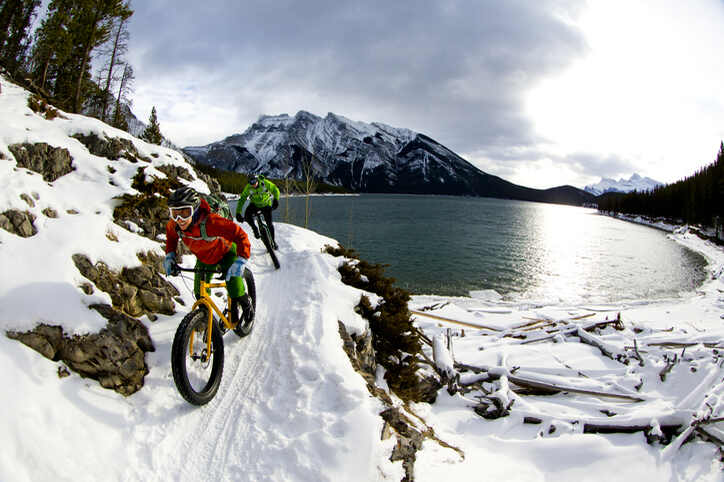A Guide to Backpacking Spain
When backpacking Spain, here’s how you must plan your trip and explore top destinations to experience its rich culture, cuisine, heritage and more.
A Guide to Backpacking Spain’s Rich Culture, Cuisine and Sun-Kissed Coasts
- The best time to go backpacking in Spain is during the shoulder seasons (March-May and September-November) to avoid crowds and high prices.
- You can easily travel within Spain through its well-connected bus and train network.
- Planning is essential for a smooth backpacking trip in Spain. This includes researching destinations, getting travel insurance, and choosing the right gear.
Backpacking Spain isn't just a vacation; it's an immersive journey into a country overflowing with cultural richness, breathtaking landscapes, and a legendary cuisine.
But to truly experience its magic, planning is essential. This guide will equip you with the knowledge to craft an unforgettable backpacking adventure through Spain, from creating the perfect itinerary to staying safe on your journey.
Things To Do, Before You Go Backpacking in Spain
So, you got an itch to explore Spain on a backpacker’s budget?
Here’s a breakdown of everything to need to prepare for the trip:
1. Choose your dates according to your interests
Summers in Spain are hot, while the winters are mild. So, if you want to go hiking aim for early summer before it gets too hot and to also avoid rainy season. But if you want to go on a cultural trail, you will have to select dates that coincide with various festivals and events that pique your interest.
2. Research and plan your itinerary
Decide what kind of experiences you're looking for (hiking, cultural immersion, city exploration) and research regions that align with your interests. You must also investigate local buses, trains, or budget airlines to connect between destinations.
Hostels are a great choice for budget-conscious backpackers and offers opportunities to meet fellow travelers. You may also consider guesthouses or campgrounds for a more local experience.
3. Get Visa and Documentations
Citizens from the United States (and a few other countries ) don't require a visa for short tourist stays (less than 90 days within 180 days) in Spain. So, if you are backpacking to Spain for a period less than 90 days, you will need:
- Valid passport: Your passport must be valid for at least three months beyond your intended departure date from Spain.
- Proof of onward travel: Spanish immigration officials may ask for proof that you have a return flight ticket or ticket to your next destination.
- Sufficient funds: Be prepared to show evidence of sufficient funds to cover your stay in Spain. This could include bank statements, credit cards, or traveler's checks.
If your trip to Spain exceeds 90 days or you're traveling for reasons other than tourism (e.g., work, study), you will need to apply for the appropriate visa before your trip.
4. Consider Travel Insurance
Consider travel insurance to protect your backpacking vacation against unexpected situations like trip cancellations, medical emergencies, or lost luggage. Compare different AXA Travel Protection Plans and choose the right coverage limits that meet your needs.
You may also look for features like " Cancel for Any Reason " for protection even if you need to cancel for unforeseen personal circumstances. Meanwhile, medical expense coverage can be great for seniors, as general health insurance or Medicare might not be applicable in Italy.
5. Book in Advance
Prices for flight or cruise tickets soar up, especially during peak season. Book early to secure the best deals. Hostels are generally cost-effective options for solo backpackers, but if you have traveling partners, look for deals on hotels and secure a place in advance.
The same applies for booking your travel insurance.
6. Learn about Local Customs, Etiquettes and Language
Religious sites in Spain often have dress codes. Men may need to cover their shoulders and knees, while women may need to cover their shoulders.
Also, tipping in Spain is not mandatory, but it's always appreciated.
While English is spoken in prime destinations, knowing a few key phrases in Spanish will be helpful. It will be easier for you to communicate with locals, order food, ask for directions, and navigate in non-touristy areas.
3 Week Itinerary for Backpacking Through Spain
You might be planning to travel to Spain, with your own timeline, but generally, three weeks is a great amount of time to explore the many different regions of Spain.
This 3-week itinerary takes you around the best cities to visit in Spain (from Barcelona and Madrid), exploring the country's culture and landscapes (as in the charming villages of Andalusia). You may extend or reduce your stay at specific destinations according to your preferences.
Barcelona (4-5 days)
Barcelona is one of the most beautiful cities in the world and holds a special place in the hearts of architecture lovers. You may start by exploring iconic landmarks such as La Sagrada Familia, Park Güell, and Las Ramblas.
Or you may dig deeper into the city's character by wandering the charming streets and plazas of the Gothic Quarter and El Born on foot. These places also offer several affordable stays for backpackers.
Next, you can take a side trip to Girona, a nearby town rich in history, and explore its Jewish Quarters and Cathedral. For a change of pace, unwind on the city's beaches like Barceloneta. And for the adventurous, a hike to the mountain monastery of Montserrat awaits, offering stunning scenery.
Valencia (2-3 days)
The first thing to do in Valencia is to find yourself a hostel or budget hotel in the city center. It will allow you to gain maximum access to all the main attractions around and save you travel time.
On day one, explore the historic city center itself. The Valencia Cathedral, Plaza de la Virgen, and the Fuente de los Leones fountain are must-visit attractions here. With more time on your hands, consider having a slow stroll through the Barrio del Carmen, the old Bohemian quarter. Enjoy the best food Valencia has to offer at the Central Market, which is also a stunning Modernist building.
On day two, take a day trip to the town of Montanejos in northern Valencia. It is known for its natural hot springs and travertine pools. It is a beautiful backpacking trail in Spain, as it leads through mountains alongside the Mijares river.
You can carry on with the hiking adventure on day three and visit the famous Route of the Hanging Bridges. It goes through the Los Calderones Natural Park, crossing several suspension bridges. Here you will also see impressive canyons carved by the Turia River.
Granada (2-3 days)
If you ask where you get the best tapas in Spain - it is Granada. They come complimentary with drinks, and the portions keep increasing with each order. So, day one in Granada calls for sightseeing around the city and enjoying the delicious local food.
The Granada Cathedral boasts impressive Spanish Renaissance architecture. Reserve the evening for the infamous Sacromonte neighborhood. By the evening, you will get to enjoy the intimate flamenco shows in its unique cave houses, and may be that’s why is counts among the best cities to visit in Spain.
You can also visit the stunning Alhambra palace and its garden and also explore the historic Albaicín neighborhood with its narrow streets and white-washed houses.
If time allows, consider a short hike in the Sierra Nevada mountains near Granada for beautiful views and nature experiences before you take a train or bus out to Seville, your next destination en route. You must also reserve a day for the thrilling El Caminito Del Rey trail located in the nearby province of Málaga.
Seville (3-4 days)
Next, you make your way to Seville, the capital of Andalusia, where the Seville Cathedral, the third-largest church in the world - is quite a tourist magnet. But as a backpacker, you will also love exploring the picturesque town that features a blend of Moorish, Christian, and Jewish architecture.
The Santa Cruz district offers central yet cost-effective options for stay. You may want to extend your stay here as a minimum of 2 days are required to explore the central city, and there are many options for day trips from Seville.
The Alcázar palace, Plaza de España (an iconic semicircular plaza in Maria Luisa Park) and Metropol Parasol (a modern wooden mushroom-like structure) are also worth visiting in Seville.
You may also take a day to visit the nearby city of Córdoba. Explore its historic Jewish Quarters, Calleja de las Flores and the Mezquita, a unique mosque-cathedral. You can go on a boat tour along the Guadalquivir River.
While traditionally a long-distance pilgrimage route, sections of the Camino de Santiago near Seville offer beautiful backpacking trails in Spain for various levels of hikers. Another famous hiking trail is Cerro del Hierro, which is set in the breathtaking Sierra Norte mountain range.
Toledo (1-2 days)
Toledo is a fascinating city to explore on a short backpacking trip. You will be surprised how much this compact-sized city has to offer, all at a walkable distance.
The historic city center has the Primate Cathedral of Saint Mary of Toledo, the Alcázar, the Synagogue of El Tránsito, the Monastery of San Juan de los Reyes, and the Sephardic Museum.
Here, you must get the Toledo Card, which provides discounted entry to many attractions. Don’t forget to enjoy the local cuisine, including marzipan, Manchego cheese, and Serrano ham.
Make the most of your trip by taking a day trip to the nearby town of Consuegra to see the famous windmills and hike along the Tagus River.
Madrid (3-4 days)
Once in Madrid, you can spend a couple of days exploring the city or set out directly to its Sierra de Guadarrama National Park, which has many hiking trails. La Pedriza Labyrinth is the most mystical and demanding trail around here, but has unique granite formations and waterfalls, making it all worthwhile.
The loop trail around Monasterio de El Paular is more peaceful. For the more adventurous ones, the 2-day traverse hike with an overnight bivouac in the La Pedriza takes you to Europe's largest granite environment.
When in the city, visit the Prado Museum, one of the finest art museums in the world, explore the Royal Palace of Madrid, and wander through the Retiro Park. Whether or not you are an art fan, do visit the Reina Sofia Museum to see Picasso's famous painting Guernica. The Corral de la Morería, also known as the 'Cathedral of Flamenco Art' will also be a soothing checkbox to tick.
The Mercado de San Miguel is your go-to spot for a food tour and trying traditional Spanish tapas. La Latina and Malasaña districts have some visit-worthy pintxos bars. Do try churros con chocolate at the famous San Gines café.
San Sebastian (2-3 days)
San Sebastian allows for a more relaxed backpacking trip. Explore this charming old town and visit San Vincente Church, Basilica of Santa Maria, and El Buen Pastor Cathedral. The San Telmo Museum is the oldest museum dedicated to Basque history and culture.
Then, you may take a hiking day trip up to La Mota Castle on Mount Urgull and enjoy the panoramic views of the city from afar. If time permits, take a rental car to the Divine Gorge or Ruta Del Cares hiking trail through the Picos de Europa mountain range.
A trip to San Sebastian is incomplete without La Concha Beach, listed as one of the best urban beaches in the world.
Here’s a table for an estimate of travel times between these 7 major cities in Spain:
|
City Pair |
Train Time |
Bus Time |
|
Barcelona - Valencia |
2 - 3 hours |
3 - 4 hours |
|
Valencia - Granada |
5 - 7 hours |
7 - 9 hours |
|
Granada - Seville |
2 - 3 hours |
4 - 5 hours |
|
Seville - Toledo |
4 - 6 hours |
Not recommended (Long & Indirect) |
|
Toledo - Madrid |
Not recommended (Short distance) |
1 - 1.5 hours |
|
Madrid - San Sebastian |
4 - 5 hours |
5 - 7 hours |
What to Pack for Travel to Spain?
When selecting what goes inside your backpack, follow this one ultimate goal – pack everything you need while keeping your backpack light. Use the following list to tick off the primary stuff:
- Quick drying clothes and travel towels
- A pair of walking shoes
- Sun protection: Hats, Sunglasses, Sunscreen
- Swimsuit / trunks
- Light jacket
- Water bottle
- Charger, powerbanks
- Local Currency (Euro)
- Sleeping bag
- Map guides
Most important of all is the backpack itself. Choose a lightweight one with multiple compartments that allow for easy organization.
How to Budget Your Travel to Spain
Budgeting wisely can make a big difference in how far your money stretches. You won’t have to spend a fortune while exploring Spain. Here are some tips to make the most of your budget:
-
Stay in hostels: Hostels are your best bet, offering dorm beds for as low as $20 a night. You may choose guesthouses or small hotels for occasional splurges.
-
Save on food: If there is a way to try out local flavors and save money, it is tapas crawls. Most hostels have communal kitchens, so you can opt for these and skip dining out.
-
Train travel cards: Trains in Spain connect major cities effectively. You can avail day passes for unlimited travel within a specific area. Consider overnight journeys and also save on accommodation.
To further cut costs, consider cooking your own meals at times and taking advantage of free attractions and walking tours.
How to be Safe When Backpacking in Spain Alone?
Spain is a safe country for travelers. But as with any other travel destination, staying vigilant is necessary. Don’t carry too much cash. You will find ample ATMs around the major cities of Spain. Use a money belt and keep it under a layer of clothing to be on the safer side.
From the “accidental” bump and grab to fake charity scams, thieves come with many clever ways to dope tourists. Keep your eyes on your belongings, especially in crowded places.
Your travel documents are as valuable as money. Make copies of important documents like your passport, ID, and travel insurance. Keep these photocopies separate from the originals in case of loss or theft. It is also a good idea to let someone back home know your plans.
Also Read: Spain Travel, Spain Travel Requirements, Is it Safe to Travel to Spain, 10 Must See Places: Spain, Summer in Spain, Backpacking Travel Insurance
FAQs
1. What is the best time to go backpacking in Spain?
The months from March to May and September to November are shoulder seasons. The weather is not too hot, and also you can expect fewer crowds at major tourist destinations. If you are looking for a beach party vibe, June and July are the best months. But you would encounter higher prices and more crowds.
2. What are the three most important things to do in Spain?
It's tough to pick just 3, but in Spain, don't miss the chance to:
- Explore its great architecture - Barcelona's Sagrada Familia or Granada's Alhambra palace are must visit sites.
- Immerse yourself in the vibrant culture. For example, try tapas in Madrid or witnessing a fiery flamenco show in Seville.
- Travel beyond the cities and unwind on Spain’s pristine beaches or historic trails like that to Camino de Santiago.
3. Are there any festivals that I can catch during my trip?
Spain is a country that loves to celebrate. Depending on when are you planning your backpacking trip, there are some famous festivals you can attend. You may time your trip to La Tomatina, which is held in August in Buñol, Las Fallas, celebrated in March in Valencia, or the Running of the Bulls in Pamplona, which happens in July.
4. Do I need travel insurance for backpacking in Spain?
Travel insurance isn't mandatory for Spain, but it's highly recommended. It can offer coverage for you from unexpected events like medical emergencies, trip cancellations, lost luggage, and even theft. Be sure to choose the right travel insurance for your Spain backpacking trip .
5. Which credit cards are accepted in Spain?
Both VISA and Mastercard are widely accepted in Spain. You can use them for payments in shops, restaurants, and other commercial establishments. If you have American Express, Diner’s Club, Discovery, or another credit card, it is recommended to check with your provider directly for service availability.
6. Which cell phone can I use in Spain?
You can use your country's cell phone in Spain with an original SIM card if your carrier offers international roaming plans. Alternatively, consider getting a local SIM card for cost-effective calling and data options.

Get AXA Travel Insurance and travel worry free!
Travel Assistance Wherever, Whenever
Speak with one of our licensed representatives or our 24/7 multilingual insurance advisors to find the coverage you need for your next trip Get an instant quote!




